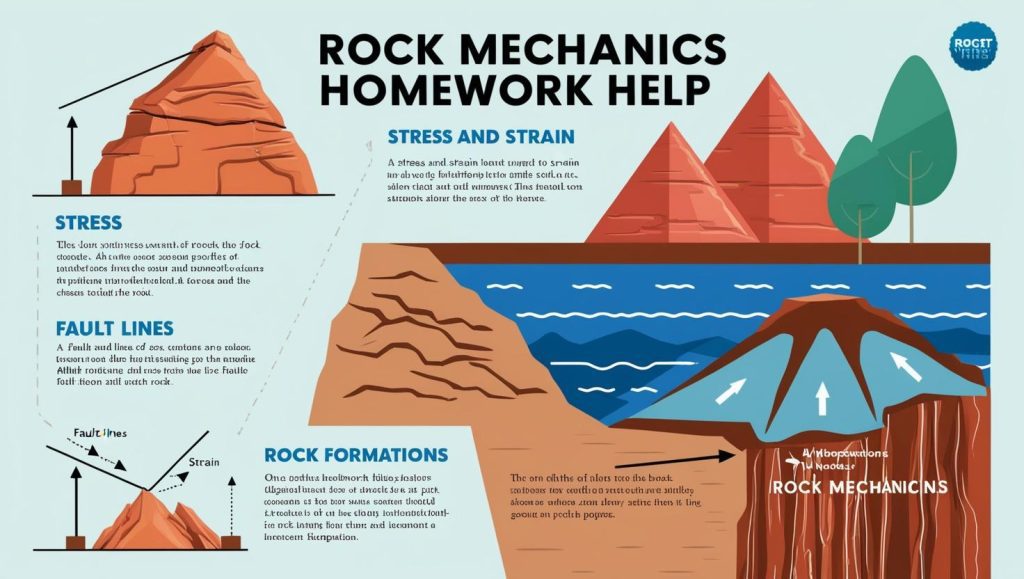Introduction
The Elements Of Rock Mechanics Homework Help is an essential subject in geology, mining engineering, and civil engineering. Rock mechanics is the study of the behavior of rock materials under various physical and environmental conditions. It plays a crucial role in mining, tunneling, and infrastructure development. This blog provides an in-depth guide on rock mechanics, covering fundamental principles, testing methods, applications, and challenges. Whether you’re a student looking for homework help or a professional seeking insights, this guide will be highly beneficial.

Understanding Rock Mechanics
Rock mechanics is a branch of geotechnical engineering that focuses on the mechanical properties of rocks and their response to applied forces. It is crucial for designing stable structures in mining, construction, and oil and gas exploration.
Key Elements of Rock Mechanics
- Stress and Strain in Rocks: Understanding how rocks respond to external forces is fundamental in rock mechanics.
- Rock Strength and Deformation: The ability of rocks to withstand compression, tension, and shear forces.
- Fracture Mechanics: The study of crack initiation and propagation in rock materials.
- Rock Mass Classification: Methods to evaluate rock quality for engineering purposes.
- Groundwater Influence on Rocks: The impact of water pressure on rock stability.
Testing Methods in Rock Mechanics
To determine the mechanical properties of rocks, engineers conduct various laboratory and field tests. These include:
1. Uniaxial and Triaxial Compression Tests
These tests measure the strength and deformation characteristics of rock samples under controlled stress conditions.
2. Brazilian Tensile Strength Test
A test used to evaluate the tensile strength of rocks, which is crucial for understanding fracture mechanics.
3. Point Load Test
A simple and quick method for estimating rock strength in field conditions.
4. Shear Strength Test
Determines the resistance of rock surfaces to sliding forces, which is important for slope stability analysis.
5. Acoustic Emission Testing
Monitors microcrack activity in rocks to predict potential failure zones in engineering projects.
Applications of Rock Mechanics
Rock mechanics is widely applied in various industries, including:
1. Mining Engineering
- Slope Stability Analysis: Ensuring safe excavation in open-pit and underground mining.
- Rockburst Prediction: Assessing the risk of sudden rock failures in deep mines.
2. Civil Engineering
- Tunnel Design and Stability: Ensuring the structural integrity of tunnels in rock formations.
- Foundation Engineering: Evaluating rock properties for stable building foundations.
3. Oil and Gas Exploration
- Wellbore Stability: Preventing rock collapse around oil and gas wells.
- Hydraulic Fracturing: Understanding fracture propagation for efficient resource extraction.
Challenges in Rock Mechanics
Rock mechanics involves several challenges that engineers must address, such as:
1. Heterogeneity of Rock Materials
Rocks have varying properties, making it difficult to predict their behavior accurately.
2. Environmental and Climatic Factors
Weathering, groundwater flow, and seismic activities impact rock stability and engineering designs.
3. Scale Effects in Testing
Laboratory test results may not always represent real-world conditions due to scale differences.
4. Monitoring and Prediction Limitations
Developing accurate models for predicting rock failures remains a challenge despite technological advancements.
Future Trends in Rock Mechanics
Advancements in technology and research are improving the field of rock mechanics. Future developments include:
- AI and Machine Learning: Enhancing rock stability prediction and risk assessment.
- 3D Geological Modeling: Improving visualization and analysis of rock formations.
- Sustainable Engineering Practices: Reducing environmental impacts in mining and construction projects.
Conclusion
Understanding the Elements Of Rock Mechanics Homework Help is essential for students and professionals in mining, geology, and engineering. The study of rock behavior under stress conditions helps in designing safer and more efficient structures. With advancements in testing methods and technology, rock mechanics continues to play a vital role in modern infrastructure and resource extraction.
For more insights into rock mechanics and geotechnical engineering, visit International Society for Rock Mechanics (ISRM) or Geological Society of London.


